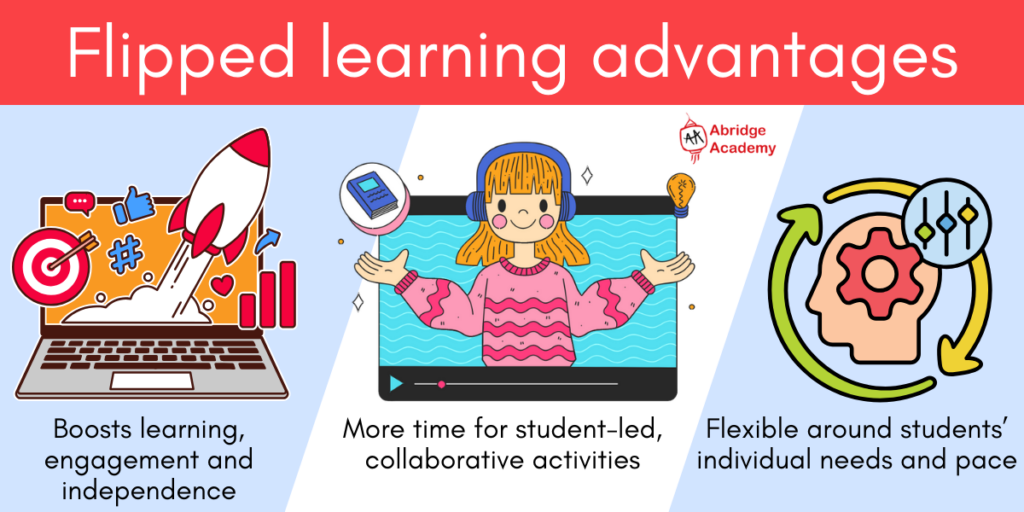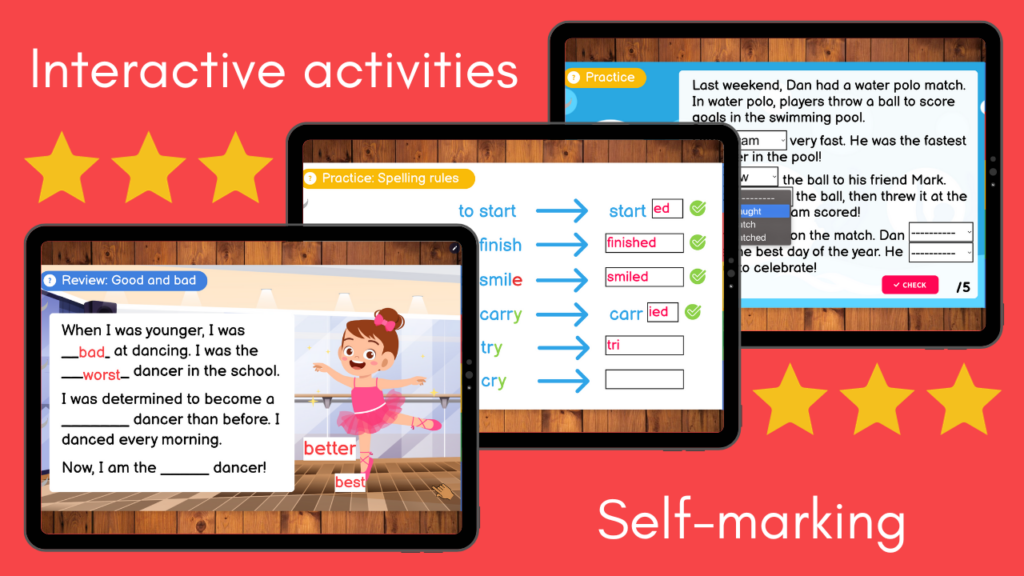Do your students turn up to class unprepared, causing you to waste lesson time going over the basics?
Research shows that a flipped learning approach, in which students pre-learn key ideas before class, significantly boosts students’ language learning results and attitudes1. In recent years, technological developments and the gamification of learning have enabled more active participation in flipped learning, further improving outcomes2.
As an independent online ESL teacher, flipped learning can help you teach your students more effectively, as well as provide a more well-rounded and holistic learning environment for your students. Parents LOVE having out-of-class learning materials too, as they recognise their importance for maximising progress. Ultimately, this enables you to charge more for your classes and boosts student retention, satisfaction and referrals too!
Let’s learn more about the flipped learning approach, and how the Abridge Academy curriculum can support you in flipping your online ESL classes!
What is flipped learning?

Flipped learning is a pedagogical approach in which students pre-learn key concepts before class, thus freeing up class time to focus on implementing and practicing using these ideas in a collaborative environment. Class time can then be spent on more challenging concepts which require teacher input, and applying this knowledge to learner-led group activities3.
In English language learning specifically, pre-learning could include pre-learning new vocabulary, grammar points and texts. In class, students can focus on applying these skills in context, for example with role-plays, debates, discussions and projects.
What are the advantages of flipped learning?

The advantages of flipped learning in the English language classroom include:
- Allows students to pre-learn key ideas at their own pace;
- Develops students’ independent learning skills;
- Frees up class time to focus on collaborative application of ideas in context, such as role-plays, discussions and debates;
- Reduces rote-learning and teacher-led class activities, with more time for student-led learning;
- Can be more flexibly personalised and differentiated according to individual students’ needs.
What are the disadvantages of flipped learning?
Although flipped learning has many advantages, there are also some potential disadvantages:
- If some students neglect their pre-learning, they may arrive to class unprepared so struggle to keep up;
- Students may be disadvantaged by their home life, internet access or special educational needs, so be unable to engage with pre-learning materials;
- Some students may struggle to learn concepts independently, resulting in misconceptions or learning gaps;
- Teachers may find it difficult or time-consuming to design professional and engaging flipped learning resources.
However, many of these disadvantages can be mitigated by carefully designing your pre-learning tasks and course structure accordingly.
How can teachers best support students with flipped learning?

One of the biggest challenges for students is knowing how to learn key ideas independently. When introducing the flipped learning model in class, directly teach students strategies they can use to boost memory and understanding. This includes modelling repeating and testing recall of new words, or showing students how to use online dictionaries to research word usage.
It is also important to assess students’ pre-learning at the start of class. For example, you could briefly quiz students on the new words and complete a gap-fill exercise to check their understanding. This enables you to adapt class activities accordingly, ensuring students are not rushed ahead if they had arrived to class unprepared or with misunderstandings.
Additionally, it is important to provide students with access to pre-learning materials in a manner which considers their individual needs. For example, if students struggle with organisation, you could use an LMS system such as Moodle, Google classroom or SuperTeacher to provide access to pre-learning activities in a structured system. If your students do not have access to the internet at home, offer them printed resources instead or arrange for them to use computers in school to access e-learning materials.
Finally, getting parents on-board can be critical to success with the flipped learning model. Be sure to inform parents and guardians of the importance of pre-learning for their child’s success in class, encouraging them to support their child’s progress and put together a pre-learning schedule. With young learners, it may be advisable to directly teach parents strategies they can use to work through pre-learning activities with their child at home, as they may otherwise struggle to engage independently.
How does the Abridge Academy curriculum support flipped learning?
Abridge Academy’s core curriculum materials include lesson previews and vocabulary flashcards. Lesson previews include audio recordings (in both British and American English) of new words, grammar explanations, dialogues and reading texts.

To make it easier to share with your students, there is no login required to access these resources – you can simply share the link via your preferred communication platform or LMS. Lesson previews work on all devices, including laptops, tablets and mobile phones, so your students can learn on-the-go.
Additionally, some lessons include links to videos, educational games and WordWall exercises. These are a great way for students to actively practice and assess their own knowledge before class, thus maximising learning. As a teacher, you have flexibility on how you wish to use these resources, thus enabling you to adapt pre-learning tasks according to your students’ individual needs.
In class, the Abridge Academy lessons begin by reviewing pre-learning content to assess students’ recall and understanding. Teachers can spend as much or as little time as they need consolidating new vocabulary and grammar, before dedicating as much class time as possible to putting this learning into practice.

Lessons also include plenty of interactive, collaborative and discussion-focused tasks, enabling you to make your class activities more learner-centred and focus on actively implementing new concepts.
Get started with the Abridge Academy curriculum today to supercharge your online ESL classes and save time lesson planning!
References
- Shahnama, Mojdeh & Ghonsooly, Behzad & Elahi Shirvan, Majid. (2021). A Meta-analysis of Relative Effectiveness of Flipped Learning in English as a Second/Foreign Language Research. Educational Technology Research and Development. 10.1007/s11423-021-09996-1. ↩︎
- Burke, A. S., & Fedorek, B. (2017). Does “flipping” promote engagement?: A comparison of a traditional, online, and flipped class. Active Learning in Higher Education, 18(1), 11-24. ↩︎
- Hamdan, N., McKnight, P., McKnight, K. & Arfstrom, K. (2013). A Review of Flipped Learning. Flipped Learning Network. ↩︎
